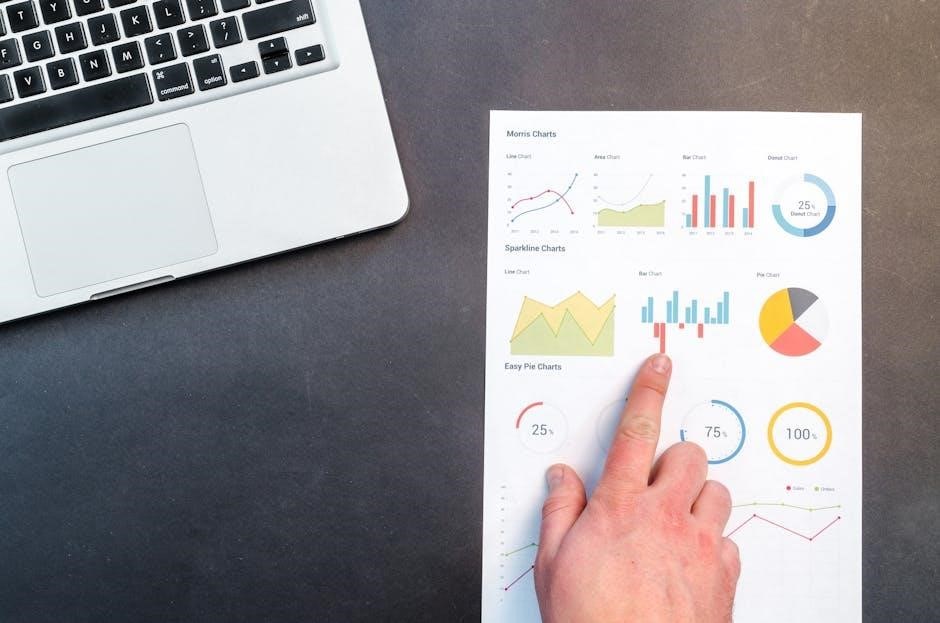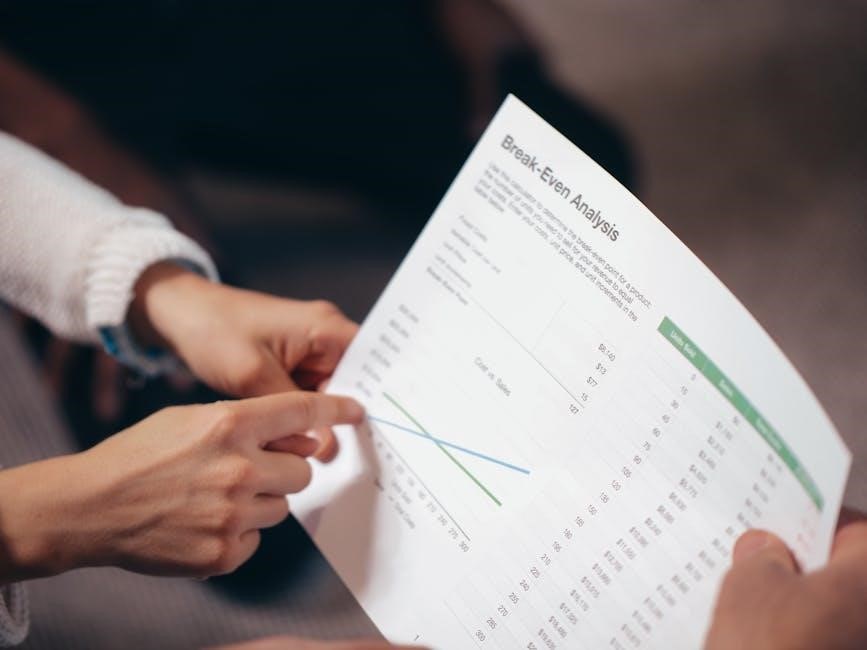A euphonium finger chart is a visual guide detailing fingerings and valve positions for notes. It helps players master the instrument’s fingering system efficiently.
What is a Euphonium Finger Chart?
A euphonium finger chart is a detailed guide illustrating the correct valve combinations and finger placements for producing specific notes on the euphonium. It visually maps fingerings for both treble and bass clef systems, catering to compensating and non-compensating instruments. The chart typically uses circles or numbers to denote valve positions and finger assignments, making it easier for players to learn and master the instrument. Available as downloadable PDFs, these charts are essential for students and professionals alike, providing a quick reference for fingerings across the euphonium’s range.
Importance of Using a Finger Chart for Euphonium Players
A finger chart is essential for euphonium players as it provides a clear, visual guide to mastering fingerings and valve combinations. It helps players learn the correct placements for notes across the instrument’s range, ensuring proper technique and consistency. By standardizing fingerings, it reduces confusion and accelerates the learning process, especially for beginners. The chart also serves as a quick reference for complex notes and alternate fingerings, making practice more efficient and effective. Regular use of a finger chart enhances tone quality, intonation, and overall musical expression, making it a vital tool for all euphonium enthusiasts.

Understanding the Layout of a Euphonium Finger Chart

A euphonium finger chart visually organizes notes and corresponding fingerings, showing valve positions and finger placements. It typically displays notes in a logical sequence, using symbols or colors to indicate specific techniques or alternate fingerings, ensuring clarity and ease of use for players of all skill levels.
How to Read the Chart
To read a euphonium finger chart, start by identifying the note names, which are typically arranged in a logical sequence. Each note is paired with a specific valve combination, indicated by numbers inside circles. For example, “1-2-3” means pressing the first, second, and third valves simultaneously, while “4” indicates using only the fourth valve. Gray backgrounds often highlight pedal tones or special notes requiring unique fingerings. Focus on the most commonly used fingerings first, as they are usually listed in order of preference. Alternate fingerings, when provided, offer options for different musical contexts, such as faster passages or tonal preferences. The chart may also include symbols or colors to denote open or closed fingerings, helping you understand whether valves should be up or down. By matching the note you wish to play with its corresponding valve combination, you can navigate the chart effectively, enhancing your playing technique and consistency over time.
Key Symbols and Markings on the Chart
The euphonium finger chart uses specific symbols to guide players. Open circles indicate valves that should remain up, while filled circles show valves to press down. Numbers inside circles represent valve combinations. Gray backgrounds highlight pedal tones or less common notes, often requiring alternate fingerings. Lines or arrows may connect notes to show smooth transitions or alternate fingerings. Some charts include color coding for clarity, distinguishing between standard and compensating system fingerings. Understanding these symbols is crucial for accurate note production and effective use of the chart. Proper interpretation ensures mastery of the instrument’s fingering system.

Basic Fingering Techniques for the Euphonium
Mastering basic fingerings involves proper finger placement and valve operation. Techniques vary between lower and upper registers, requiring consistent practice for smooth transitions and accurate note production.
Fingering Positions for Notes in the Lower Register
The lower register of the euphonium typically starts around E and extends downward. Notes in this range often use fewer valves, with fingerings like 1 for E, 1-2 for F, and 1-3 for F#. G is usually played with 1-2-3, while Gb may use 1-2-4. A is often 1-2, and Ab can be 1-3 or 1-2-3. Bb typically uses 1-2-3-4, and C may require 2-3 or 2-4. Each note has specific valve combinations, and proper finger placement ensures clarity and pitch accuracy. Practicing these fingerings in exercises helps build consistency and control in the lower register.
Fingering Positions for Notes in the Upper Register

The upper register of the euphonium spans from middle C upward. Notes like D and Eb often use valve combinations such as 1-2 or 1-3. E and F require precise fingerings, with E typically using 1-2-3 and F using 1-2-3-4. G and Ab may involve alternate fingerings like 1-2-4 or 1-3-4 for better intonation. A and Bb in the upper register often use 1-2 or 1-3, while C and Db may require 2-3 or 2-4. These fingerings vary slightly between compensating and non-compensating systems, emphasizing the need for consistent practice to maintain tone quality and accuracy in the upper range.
Advanced Fingering Techniques
Advanced techniques involve chromatic scales and alternate fingerings for complex passages. These methods enhance pitch accuracy and tone consistency, especially in the upper register and for advanced repertoire.
Chromatic Fingering Chart for Euphonium
A chromatic fingering chart for euphonium lists fingerings for all twelve semitones within an octave. It helps players navigate complex, chromatic passages with precision and clarity. Each note, from lows to highs, is paired with its optimal valve combination, ensuring proper intonation and ease of play. Advanced charts also include alternate fingerings for specific musical contexts, making it an essential tool for both students and professionals aiming to master technical challenges.
Alternate Fingerings and Their Uses
Alternate fingerings provide multiple valve combinations for the same pitch, offering flexibility for euphonium players. These options help in maintaining smooth transitions, improving intonation, and reducing fatigue during challenging passages. Alternate fingerings are particularly useful in chromatic music, where quick valve changes are necessary for accuracy. They also cater to individual preferences and ergonomic needs, enhancing overall performance consistency and musicality. familiarizing oneself with these alternatives expands technical versatility, making the chart an invaluable resource for mastering diverse repertoire.
Comparing Different Types of Euphonium Finger Charts
Euphonium finger charts vary by clef (treble or bass) and instrument type (compensating or non-compensating systems). Treble clef charts are common for euphonium, while bass clef suits baritone. Resources from Norlan Bewley and Dr. Yutaka Kono provide detailed comparisons, ensuring players can choose charts that match their instrument and playing style for optimal performance.
Treble Clef vs. Bass Clef Finger Charts
Treble clef finger charts are predominantly used for euphonium, accommodating its natural pitch range. Bass clef charts, often for baritone, suit lower-pitched instruments. Both layouts provide fingerings, but treble clef charts typically cover higher registers, while bass clef charts focus on lower ranges. Resources like Norlan Bewley’s and Dr. Yutaka Kono’s charts highlight these differences, ensuring players select appropriate charts based on their instrument and musical context to achieve accurate intonation and technique.
Compensating vs. Non-Compensating Systems
Euphonium finger charts often cater to compensating and non-compensating systems. Non-compensating systems, found in standard euphoniums, use fewer valves, simplifying fingerings. Compensating systems, common in advanced instruments, feature additional valves for improved intonation, especially in lower registers. Charts like Norlan Bewley’s and Dr; Yutaka Kono’s distinguish these systems, guiding players to optimal fingerings. Understanding these differences is crucial for selecting the right chart, ensuring accurate pitch and tone production across the euphonium’s range.

Resources for Downloading a Euphonium Finger Chart PDF
Visit websites like norlanbewley.com, olemiss.edu, or yutakatubamac.com for high-quality euphonium finger charts. These sites offer free PDF downloads, ensuring easy access to essential fingering guides.
Recommended Websites for High-Quality Charts
Norlan Bewley’s website (norlanbewley.com) offers comprehensive PDF charts for euphonium, covering both compensating and non-compensating systems. The University of Mississippi (olemiss.edu) provides chromatic fingering charts by Micah Everett, ideal for advanced players. Dr. Yutaka Kono’s charts, available at yutakatubamac.com, are widely respected for their clarity and detail. These sites ensure access to accurate and well-structured finger charts, catering to players of all skill levels and preferences.
How to Print and Use the Chart Effectively
Download the PDF from trusted sources like Norlan Bewley or the University of Mississippi. Print it on high-quality cardstock for durability. Laminate the chart to protect it from wear. Bind it securely for easy reference during practice. Use a metronome to practice fingerings systematically. Highlight complex fingerings for focused practice. Keep the chart visible while playing to ensure accurate technique. Regularly review and update your chart to refine your skills. This methodical approach ensures consistent improvement in euphonium performance.
Practicing with the Euphonium Finger Chart

The chart is an essential tool for guided practice, helping players improve accuracy and consistency. Regular use aids in developing muscle memory and mastering note fingerings effectively.

Exercises to Master the Fingerings
Start with long tones to develop tone and pitch accuracy. Practice scales and arpeggios across the range, focusing on smooth transitions between notes. Use lip slurs to improve flexibility and intonation. Begin with slow tempos and gradually increase speed. Incorporate chromatic exercises to master alternate fingerings. Repetition of specific passages from the chart enhances muscle memory. Record sessions to track progress and refine technique. Consistent practice ensures mastery of complex fingerings and improved overall performance.
Tips for Improving Technique and Consistency
Develop consistent technique by practicing scales and arpeggios daily. Start with slow tempos and gradually increase speed for accuracy. Use a mirror to monitor posture and finger placement. Record practice sessions to track progress and refine tone. Incorporate breathing exercises to improve air control. Focus on smooth transitions between notes, especially in chromatic passages. Use lip slurs to enhance flexibility and intonation. Prioritize finger independence and dexterity through targeted exercises. Regular review of the finger chart ensures mastery of complex fingerings and consistent performance quality.
A euphonium finger chart is an essential tool for mastering the instrument. Regular practice and chart reference will enhance technique, ensuring consistent and skilled performances over time.
Final Thoughts on the Importance of a Finger Chart

A euphonium finger chart is indispensable for mastering the instrument. It provides clarity and consistency, helping players navigate the complexities of fingering systems. Regular use ensures efficient learning and improvement, particularly for advanced techniques. The chart serves as a quick reference for troubleshooting and refining skills. By understanding and practicing with a finger chart, euphonium players can achieve greater confidence and precision in their performances. It remains a vital tool for musicians of all skill levels, fostering musical growth and excellence.
Encouragement to Continue Practicing
Consistent practice with a euphonium finger chart yields significant progress. Even short daily sessions can lead to mastery. Embrace challenges and celebrate small improvements. The journey to proficiency is rewarding, and dedication ensures growth. Remember, each practice brings you closer to musical excellence. Stay motivated and enjoy the process of becoming a skilled euphonium player.